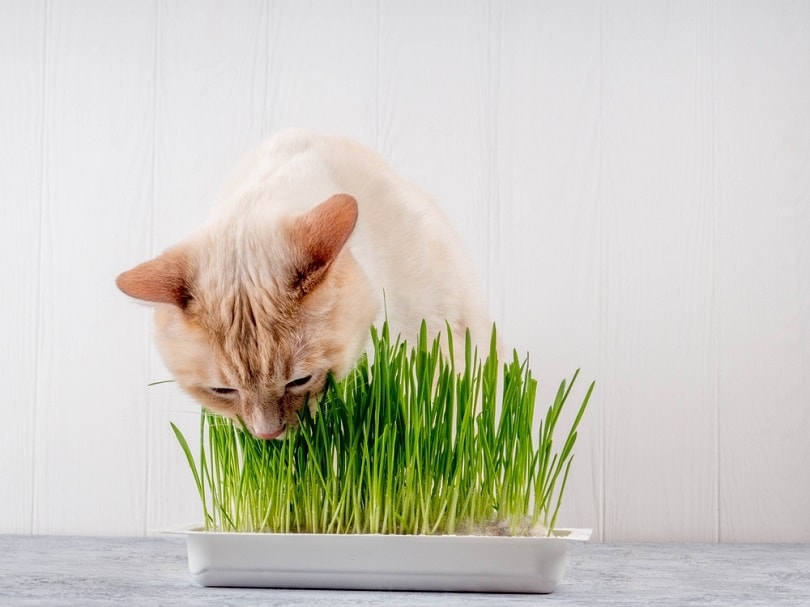Are Majesty Palms Toxic to Cats? 3 Tips for Keeping Cats Out of Plants

Updated on

Being both a cat lover and an indoor plant enthusiast is a delicate balance that we are no strangers to. Our furry friends must investigate each new green addition to the home, and part of that curiosity is almost always a taste test.
With a cat that likes to have a nibble from the plants in the home, all plants must be safe for cats if ingested or kept far away from them. It may come as some surprise, but many popular houseplants are toxic to cats.
However, some are safe. This includes the Majesty Palm, also known as the majestic palm, after long fronds resembling a crown. This popular and stylish plant is non-toxic to cats, but if eaten in large quantities, may cause some digestive discomfort.
Are Majesty Palms Safe for Cats?
Majesty Palms are among the many safe plants to keep in a household of cats. If your cat is caught nibbling on the leafy fronds or the thick stem, then no harm will be done to your cat, except maybe you get very grumpy with them!
Fortunately, Majesty Palms are non-toxic, so they won’t poison your cat if it is ingested and digested. However, the thin fibrous fronds have a small risk of being harmful if they are eaten in large quantities. The fronds will be difficult for your cat’s digestive system to break down, so they can cause gastrointestinal upset, which may result in vomiting and diarrhea.
Additionally, large amounts can conglomerate together and potentially cause a blockage in the digestive tract. This risk is low as it is not likely for a cat to eat such a large quantity of palm.

Houseplants and Cats
- Spider plant
- Ponytail palm
- Venus flytrap
- Polka dot plant
- Peperomias
- Boston fern
- Bromeliad
- Baby tears
- Orchids
- Peace lilies
- Aloe vera
- Jade plants
- Snake plant
- Ivy
- Sago palm
- Pothos
- Monstera
- Azalea
These lists are by no means exhaustive; if you are unsure, check with the ASPCA list of toxic plants to keep your household safe for cats.

Why Does My Cat Eat My Houseplants?
It can be incredibly frustrating for cat owners to keep their cats away from their precious plants constantly. So, why do cats wish to chew on them so much?
Many plants have long dangly leaves, like the Majesty Palm, or leaves that will flutter in any breeze. These movements easily capture cats’ attention and stimulate hunting drives, making plants such a fun thing to play with.
Also, while we can’t scientifically back it, we’re sure our cats just love to do the things they know get under our skin! Annoying behaviors often get a big response from us, the owners, so cats appear to engage in these behaviors to get some reaction and attention from us.
The 3 Tips for Keeping Cats Out of Plants
Don’t feel too crestfallen if your favorite plants are on the list of toxic plants to cats. Many cats and plants can coexist without cats even looking twice at them, but if your cat is known to be more curious, then you should exercise some caution.
1. Cat Grass
Another foliage can be used as a “plant sacrifice” if your cat will simply not leave your plants alone. Cat grass, catnip, and lemon balm are great examples of safe plants that cats love that may act as distractions to keep cats out of your other much-loved houseplants.

2. Deterrents
Making your plant an unappealing thing to eat will help to keep your cat at bay. There is a range of commercial deterrents available at plant stores designed outdoors to reduce cat spoilage in garden beds, but many can safely be used inside.
Additionally, cats are less likely to approach plants if the path to them is uncomfortable on their feet. Some options are pinecones, foil, and double sided sticky tape.
3. Plant placement
A sure-fire way to keep both your plant and your cat safe is to keep them separate from each other! You may consider keeping toxic plants in an inaccessible room in the home or hanging from high places. Other options include plant cages or terrariums.

Final Thoughts
Just because you have a curious cat doesn’t mean you can’t grace your home with the relaxing and beneficial presence of houseplants. Understanding what is and isn’t safe for your cat is critical, in addition to some sneaky tactics to keep your cat far away from ornamental foliage.
See Also:
Featured Image Credit: Pixelbender36, Shutterstock













